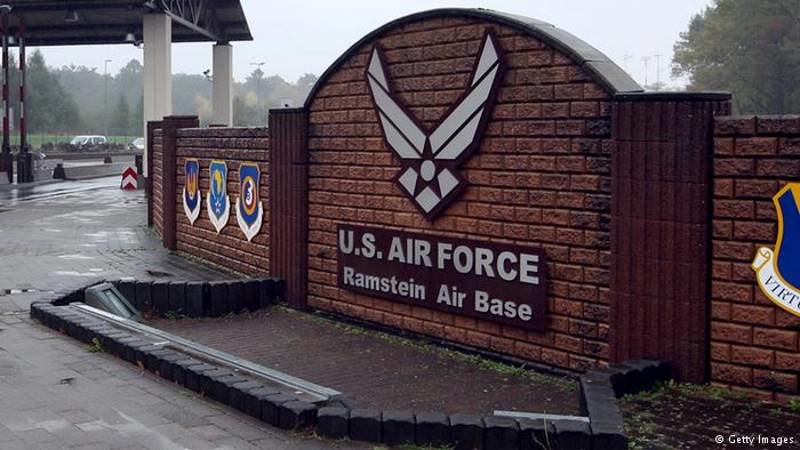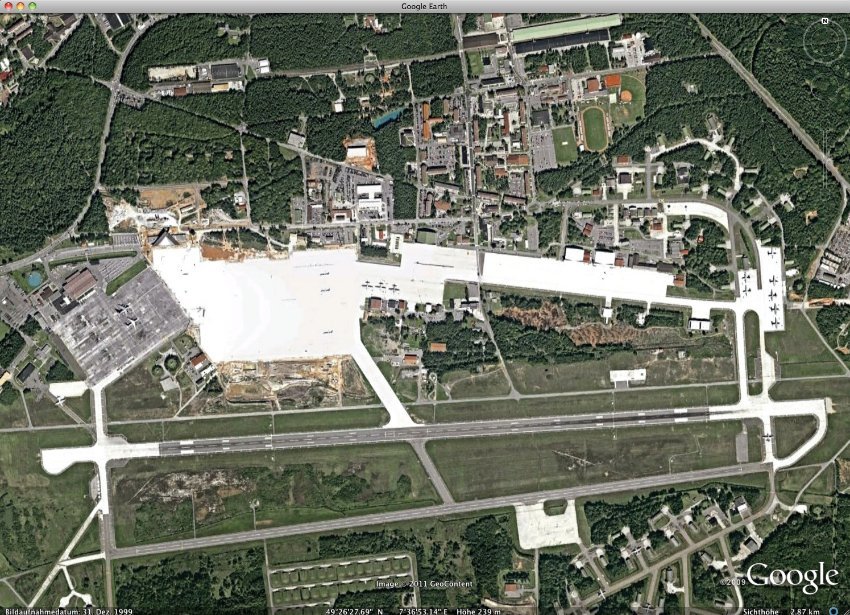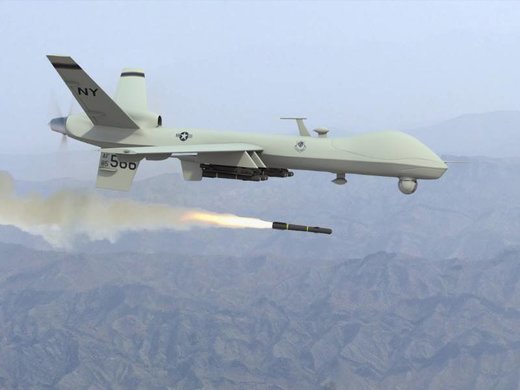The overseas hub for America's "war on terror" is the massive Ramstein Air Base in southwest Germany. Nearly ignored by US media, Ramstein serves crucial functions for drone warfare and much more. It's the most important Air Force base abroad, operating as a kind of grand central station for airborne war - whether relaying video images of drone targets in Afghanistan to remote pilots with trigger fingers in Nevada, or airlifting special-ops units on missions to Africa, or transporting munitions for airstrikes in Syria and Iraq. Soaking up billions of taxpayer dollars, Ramstein has scarcely lacked for anything from the home country, other than scrutiny.
Known as "Little America" in this mainly rural corner of Germany, the area now includes 57,000 US citizens clustered around Ramstein and a dozen smaller bases. The Defense Department calls it "the largest American community outside of the United States." Ramstein serves as the biggest Air Force cargo port beyond US borders, providing "full spectrum airfield operations" along with "world-class airlift and expeditionary combat support." The base also touts "superior" services and "exceptional quality of life." To look at Ramstein and environs is to peer into a faraway mirror for the United States; what's inside the frame is normality for endless war.
Ramstein's gigantic Exchange store (largest in the US military) is the centerpiece for an oversize shopping mall, just like back home. A greeting from the Holy Family Catholic Community at Ramstein tells newcomers: "We know that being in the military means having to endure frequent moves to different assignments. This is part of the price we pay by serving our country." Five American colleges have campuses on the base. Ellenmarie Zwank Brown, who identifies herself as "an Air Force wife and a physician," is reassuring in a cheerful guidebook that she wrote for new arrivals: "If you are scared of giving up your American traditions, don't worry! The military goes out of its way to give military members an American way of life while living in Germany."
That way of life is contoured around nonstop war. Ramstein is the headquarters for the US Air Force in Europe, and the base is now pivotal for using air power on other continents. "We touch a good chunk of the world right from Ramstein," a public-affairs officer, Maj. Tony Wickman, told me during a recent tour of the base. "We think of it as a power-projection platform." The scope of that projection is vast, with "areas of responsibility" that include Europe, Russia, and Africa - 104 countries in all. And Ramstein is well-staffed to meet the challenge, with over 7,500 "active duty Airmen" - more than any other US military base in the world except the Lackland Air Force Base in San Antonio.
Serving the transport needs of war efforts in Iraq and Syria (countries hit by 28,675 US bombs and missiles last year) as well as in many other nations, Ramstein is a central pit stop for enormous cargo jets like the C-5 Galaxy and C-17 Globemaster. The Ramstein base currently supports "fifteen different major combat operations," moving the daily supply chain and conducting urgent airlifts. Last July, when Ankara gave Washington a green light to use Turkey's Incirlik Air Base for launching airstrikes in Syria, vital equipment quickly flew from Ramstein to Incirlik so F-16s could start bombing.
But these days a lot of Ramstein's attention is focused southward. The base maintains a fleet of fourteen newest-model C-130 turboprops, now coming in mighty handy for secretive US military moves across much of Africa. With its sleek digital avionics, the cockpit of a C-130J looked impressive. But more notable was the plane's spacious cargo bay, where a pilot explained that it can carry up to 44,000 pounds of supplies - or as many as 92 Army Airborne "jumpers," who can each be saddled with enough weapons and gear to weigh in at 400 pounds. From the air, troops or freight - even steamrollers, road graders, and Humvees - leave the plane's hold with parachutes. Or the agile plane can land on "undeveloped air fields."
With Ramstein as its home, the C-130J is ideal for flying war matériel and special-operations forces to remote terrain in northern and western Africa. (The Pentagon describes it as "a rugged combat transporter designed to take off and land at austere fields.") In mid-2014, the itinerary of a single trip got into a fleeting news story when a teenage stowaway was found dead in a wheel well of a C-130J at Ramstein, after the plane returned from a circuit to Tunisia, Mali, Senegal, and Chad. Stealthy intervention has escalated widely in the two years since journalist Nick Turse found that the US military was already averaging "far more than a mission a day on the continent, conducting operations with almost every African military force, in almost every African country."
The officers I met at Ramstein in early spring often mentioned Africa. But the base mission of "power projection" hardly stops there.
In the American foreign policy lexicon, peace has become implausible, a faded memory, a mythic rationale for excelling at war. An airlift squadron at the Ramstein Air Base, which proudly calls itself the "Fighting Doves," displays a logo of a muscular bird with dukes up. On lampposts in a town near Ramstein's gates, I saw campaign posters for Germany's Left Party (Die Linke) with a picture of a dove and a headline that could hardly have been more out of sync with the base: Wie lange wollt lhr den Frieden noch herbei-bomben? "How much longer do you want to keep achieving peace by bombing?" Such questions lack relevance when war is perceived not as a means to an end, but an end in itself.
More than ever, with relatively few US troops in combat and air war all the rage, the latest military technology is the filter of the American warrior's experience. When Ramstein's 60,800-square-foot Air and Space Operations Center opened in October 2011, the Air Force crowed that it "comes with 40 communication systems, 553 workstations, 1,500 computers, 1,700 monitors, 22,000 connections, and enough fiber optics to stretch from here to the Louvre in Paris." (Mona Lisa not included.) A news release focused on "the critical mission of monitoring the airspace above Europe and Africa" and "controlling the skies from the Arctic Circle to the Cape of Needles." But the Defense Department didn't mention that the new hyper-tech center would be vital to the USA's drone war.
Ramstein receives visual images from drones via satellite, then relays the images to sensor operators and pilots at computer terminals in the United States. "Ramstein is absolutely essential to the US drone program," says Brandon Bryant, a former Air Force sensor operator who participated in drone attacks on Iraq, Afghanistan, Pakistan, Yemen, and Somalia for five years while stationed in New Mexico and Nevada. "All information and data go through Ramstein. Everything. For the whole world."
Bryant and other sensor operators had Ramstein on speed dial: "Before we could establish a link from our ground-control station in the United States to the drone, we literally would have to call Ramstein up and say 'Hey, can you connect us to this satellite feed?' We would just pick up the phone and press the button and it automatically dials in to Ramstein." Bryant concluded that the entire system for drone strikes was set up "to take away responsibility, so that no one has responsibility for what happens."
The US government's far-flung system for extrajudicial killing uses Ramstein as a kind of digital switchboard in a process that fogs accountability and often kills bystanders. A former Air Force drone technician, Cian Westmoreland, told me that many of the technical people staffing Ramstein's Air and Space Operations Center are apt to be "none the wiser; they would just know a signal is going through."
Westmoreland was stationed in Afghanistan at the Kandahar Air Field, where he helped build a signal relay station that connected to Ramstein. He never moved a joystick to maneuver a drone and never pushed a button to help fire a missile. Yet, in 2016, Westmoreland speaks sadly of the commendations he received for helping to kill more than 200 people with drone strikes. "I did my job," he said, "and now I have to live with that."
During his work on the drone program, Westmoreland developed "a new kind of understanding of what modern warfare actually is. We're moving towards more network-centric warfare. So, orders [are] dealt out over a network, and making systems more autonomous, putting less humans in the chain. And a lot of the positions are going to be maintenance, they're technician jobs, to keep systems up and running."
Those systems strive to reduce the lag time from target zone to computer screen in Nevada. The delay during satellite transmission ("latency" in tech jargon) can last up to six seconds, depending on weather conditions and other factors, but once the signal gets to Ramstein it reaches Nevada almost instantly via fiber-optic cable. Permission to fire comes from an attack controller who "could be anywhere," as Bryant put it, "just looking at the same video feeds as us pilots and sensors. He just sits in front of a screen too." As Andrew Cockburn wrote in his recent book Kill Chain, "there is a recurrent pattern in which people become transfixed by what is on the screen, seeing what they want to see, especially when the screen - with a resolution equal to the legal definition of blindness for drivers - is representing people and events thousands of miles and several continents away."
For all its ultra-tech importance, the Air and Space Operations Center at Ramstein is just a steely link in a kill chain of command, while a kind of assembly-line Taylorism keeps producing the drone war. "I think that's part of the strength of the secrecy of the program," Bryant said. "It's fragmented." Meanwhile, "We were supposed to function and never ask questions."
Worlds away, the carnage is often lethally haphazard. For example, classified documents obtained by The Intercept shed light on a special ops series of airstrikes from January 2012 to February 2013 in northeast Afghanistan, code-named Operation Haymaker. The attacks killed more than 200 people, while only 35 were the intended targets. Such numbers may be disturbing, yet they don't convey what actually happens in human terms.
Several years ago, Pakistani photographer Noor Behram described the aftermath of a US drone attack: "There are just pieces of flesh lying around after a strike. You can't find bodies. So the locals pick up the flesh and curse America. They say that America is killing us inside our own country, inside our own homes, and only because we are Muslims."
Even without a missile strike, there are the traumatic effects of drones hovering overhead. Former New York Times reporter David Rohde recalled the sound during his captivity by the Taliban in 2009 in tribal areas of Pakistan: "The drones were terrifying. From the ground, it is impossible to determine who or what they are tracking as they circle overhead. The buzz of a distant propeller is a constant reminder of imminent death."
But such matters are as far removed from Little America in southwest Germany as they are from Big America back home.
The American drone war has long been unpopular in Germany, where polling indicates that two out of three citizens oppose it. So President Obama was eager to offer assurances during a visit to Berlin three years ago, declaring: "We do not use Germany as a launching point for unmanned drones...as part of our counterterrorism activities." But such statements miss the point, intentionally, and obscure how much the drone war depends on German hospitality.

With 10 percent of the Bundestag's seats, the Greens have the same size bloc as the other opposition party, the Left Party. "To kill people with a joystick from a safe position thousands of miles away is a disgusting and inhumane form of terror," Sahra Wagenknecht, co-chair of the Left Party, told me. "A war is no video game - at least not for those who have not the slightest chance to defend themselves.... These extrajudicial killings are war crimes, and the German government should draw the consequences and close down the air base in Ramstein.... In my view, the drone war is a form of state terrorism, which is going to produce thousands of new terrorists."
A lawsuit filed last year in Germany focuses on a drone attack in eastern Yemen on August 29, 2012, that killed two members of the Bin Ali Jaber family, which had gathered in the village of Khashamir to celebrate a wedding. "Were it not for the help of Germany and Ramstein, men like my brother-in-law and nephew might still be alive today," said Faisal bin Ali Jaber, one of the surviving relatives behind the suit. "It is quite simple: Without Germany, US drones would not fly." But the German judiciary has rebuffed such civil suits - most recently in late April, when a court in Cologne rejected pleas about a drone strike that killed two people in Somalia, including a herdsman who was not targeted.
Chancellor Angela Merkel has played dumb about drone-related operations in her country. "The German government claims to know nothing at all," Bundestag member Ströbele said. "Either this is a lie, or the government does not want to know." The general secretary of the Berlin-based European Center for Constitutional and Human Rights, Wolfgang Kaleck, sums up the German government's strategy as "See nothing, hear nothing, say nothing." He charges that "Germany is making itself complicit in the deaths of civilians as part of the US drone war."
After an uproar over US National Security Agency spying in Germany caused the Bundestag to set up a special committee of inquiry two years ago, it became clear that surveillance issues are intertwined with Ramstein's role in a drone program that relies on cell-phone numbers to find targets. The Green Party's representative on the eight-member committee, Konstantin von Notz, sounded both pragmatic and idealistic when I interviewed him this spring at a Berlin cafe. "We assume that there is a close connection between surveillance and Ramstein," he said, "as data collected and shared by German and US intelligence services already led to drone killings coordinated via Ramstein."
Left Party CO-chair Wagenknecht was emphatic about the BND, Germany's intelligence agency. "The BND delivers phone numbers of possible drone targets to the NSA and other agencies," she told The Nation. "The BND and our foreign minister bear part of the blame. They do not only tolerate war crimes, they assist them."
The United States now has 174 military bases operating inside Germany, more than in any other country. (Japan is second, with 113.) The military presence casts a shadow over German democracy, says historian Josef Foschepoth, a professor at the University of Freiburg. "As long as there are Allied troops or military bases and facilities on German soil," he wrote in a 2014 article, "there will be Allied surveillance measures carried out on and from German soil, which means, in particular, American surveillance."
For surveillance and an array of other spooky purposes, the US government created what would become the BND at the end of World War II. "We grew it carefully," a retired senior Defense Intelligence Agency official, W. Patrick Lang, said in an interview. "They've always cooperated with us, completely and totally." Intelligence ties between the two governments remain tightly knotted. "When it comes to the secret services," Professor Foschepoth told a public forum in Berlin last summer, "there are some old legal foundations where the federal [German] government follows the American interests more than the interests of their own citizens."
Extending such talk to depict the current US military presence as bad for democracy in Germany is a third rail in German politics. When Pentagon Papers whistleblower Daniel Ellsberg quoted from Foschepoth's article at the Berlin forum - and pointedly asked, "Why are American troops here still? Why the bases?" - the panelist from the Green Party, von Notz, vehemently objected to going there. "I wouldn't open the discussion or have in the background that this is still an occupation problem or something," he said. "It's not a problem of troops somewhere - it's a problem of lacking democracy, state of law, controlling our secret services today."
Nine months later, talking with him at Café Einstein on Berlin's Kurfürstenstrasse, I asked von Notz why he'd pushed back so heatedly against the idea that US military bases are constraining German democracy. "Germany needs to take full responsibility of what is going on on its territory," he responded. "The German government can no longer hide behind a US-German relation allegedly characterized by the post - World War II occupation. Germany strictly has to ensure that the US intelligence services comply with the law without ignoring the illegal actions of its own Federal Intelligence Service [the BND]."
Whatever the state of its democracy, Germany is continuing to enable America's furtive warfare in Africa. Ramstein's many roles include serving as home to US Air Forces Africa, where a press officer gave me a handout describing the continent as "key to addressing transnational violent extremist threats." The military orders come from the United States Africa Command (AFRICOM) headquarters in Stuttgart, a two-hour drive from Ramstein.
Read the rest of this extensive report here.






Reader Comments
to our Newsletter